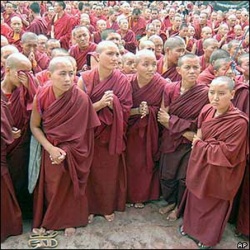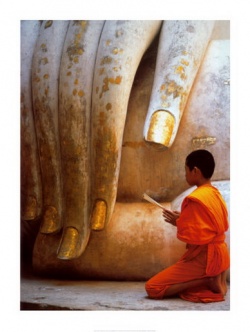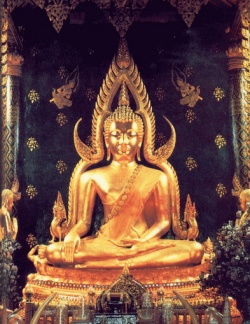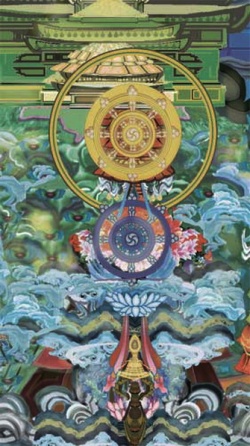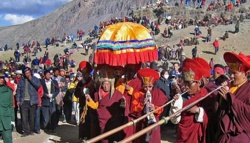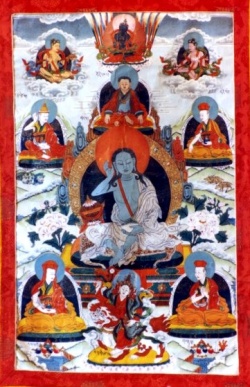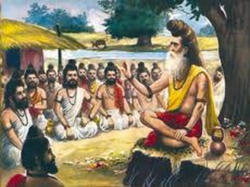The History of Buddhism: Dr. C. George Boeree
Dr. C. George Boeree
Shippensburg University
Soon after Buddha's death or parinirvana, five hundred monks met at the first council at Rajagrha, under the leadership of Kashyapa. Upali recited the monastic code (Vinaya) as he remembered it. Ananda, Buddha's cousin, friend, and favorite disciple -- and a man of prodigious memory! -- recited Buddha's lessons (the Sutras). The monks debated details and voted on final versions. These were then committed to memory by other monks, to be translated into the many languages of the Indian plains. It should be noted that Buddhism remained an oral tradition for over 200 years.
In the next few centuries, the original unity of Buddhism began to fragment. The most significant split occurred after the second council, held at Vaishali 100 years after the first. After debates between a more liberal group and traditionalists, the liberal group left and labeled themselves the Mahasangha -- "the great sangha." They would eventually evolve into the Mahayana tradition of northern Asia.
The traditionalists, now referred to as Sthaviravada or "way of the elders" (or, in Pali, Theravada), developed a complex set of philosophical ideas beyond those elucidated by Buddha. These were collected into the Abhidharma or "higher teachings." But they, too, encouraged disagreements, so that one splinter group after another left the fold. Ultimately, 18 schools developed, each with their own interpretations of various issues, and spread all over India and Southeast Asia. Today, only the school stemming from the Sri Lankan Theravadan survives.
Ashoka
One of the most significant events in the history of Buddhism is the chance encounter of the monk Nigrodha and the emperor Ashoka Maurya. Ashoka, succeeding his father after a bloody power struggle in 268 bc, found himself deeply disturbed by the carnage he caused while suppressing a revolt in the land of the Kalingas. Meeting Nigrodha convinced Emperor Ashoka to devote himself to peace. On his orders, thousands of rock pillars were erected, bearing the words of the Buddha, in the brahmi script -- the first written evidence of Buddhism. The third council of monks was held at Pataliputra, the capital of Ashoka's empire.
There is a story that tells about a poor young boy who, having nothing to give the Buddha as a gift, collected a handful of dust and innocently presented it. The Buddha smiled and accepted it with the same graciousness he accepted the gifts of wealthy admirers. That boy, it is said, was reborn as the Emperor Ashoka.
Ashoka sent missionaries all over India and beyond. Some went as far as Egypt, Palestine, and Greece. St. Origen even mentions them as having reached Britain. The Greeks of one of the Alexandrian kingdoms of northern India adopted Buddhism, after their King Menandros (Pali: Milinda) was convinced by a monk named Nagasena -- the conversation immortalized in the Milinda Pañha. A Kushan king of north India named Kanishka was also converted, and a council was held in Kashmir in about 100 ad. Greek Buddhists there recorded the Sutras on copper sheets which, unfortunately, were never recovered.
It is interesting to note that there is a saint in Orthodox Christianity named Josaphat, an Indian king whose story is essentially that of the Buddha. Josaphat is thought to be a distortion of the word bodhisattva.
Sri Lanka and Theravada
Emperor Ashoka sent one of his sons, Mahinda, and one of his daughters, Sanghamitta, a monk and a nun, to Sri Lanka (Ceylon) around the year 240 bc. The king of Sri Lanka, King Devanampiyatissa, welcomed them and was converted. One of the gifts they brought with them was a branch of the bodhi tree, which was successfully transplanted. The descendants of this branch can still be found on the island.
The fourth council was held in Sri Lanka, in the Aloka Cave, in the first century bc. During this time as well, and for the first time, the entire set of Sutras were recorded in the Pali language on palm leaves. This became Theravada's Pali Canon, from which so much of our knowledge of Buddhism stems. It is also called the Tripitaka (Pali: Tipitaka), or three baskets: The three sections of the canon are the Vinaya Pitaka (the monastic law), the Sutta Pitaka (words of the Buddha), and the Abhidamma Pitaka (the philosophical commentaries).
In a very real sense, Sri Lanka's monks may be credited with saving the Theravada tradition: Although it had spread once from India all over southeast Asia, it had nearly died out due to competition from Hinduism and Islam, as well as war and colonialism. Theravada monks spread their tradition from Sri Lanka to Burma, Thailand, Malaysia, Cambodia, and Laos, and from these lands to Europe and the west generally.
Mahayana
Mahayana began in the first century bc, as a development of the Mahasangha rebellion. Their more liberal attitudes toward monastic tradition allowed the lay community to have a greater voice in the nature of Buddhism. For better or worse, the simpler needs of the common folk were easier for the Mahayanists to meet. For example, the people were used to gods and heroes. So, the Trikaya (three bodies) doctrine came into being: Not only was Buddha a man who became enlightened, he was also represented by various god-like Buddhas in various appealing heavens, as well as by the Dharma itself, or Shunyata (emptiness), or Buddha-Mind, depending on which interpretation we look at -- sort of a Buddhist Father, Son, and Holy Ghost!
More important, however, was the increased importance of the Bodhisattva. A Bodhisattva is someone who has attained enlightenment, but who chooses to remain in this world of Samsara in order to bring others to enlightenment. He is a lot like a saint, a spiritual hero, for the people to admire and appeal to.
Along with new ideas came new scriptures. Also called Sutras, they are often attributed to Buddha himself, sometimes as special transmissions that Buddha supposedly felt were too difficult for his original listeners and therefore were hidden until the times were ripe. The most significant of these new Sutras are these:
Prajñaparamita or Perfection of Wisdom, an enormous collection of often esoteric texts, including the famous Heart Sutra and Diamond Sutra. The earliest known piece of printing in the world is, in fact, a copy of the Diamond Sutra, printed in China in 868 ad.
Suddharma-pundarika or White Lotus of the True Dharma, also often esoteric, includes the Avalokiteshwara Sutra, a prayer to that Bodhisattva.
Vimalakirti-nirdesha or Vimalakirti's Exposition, is the teachings of and stories about the enlightened householder Vimalakirti.
Shurangama-samadhi or Hero's Sutra, provides a guide to meditation, shunyata, and the bodhisattva. It is most popular among Zen Buddhists
Sukhavati-vyuha or Pure Land Sutra, is the most important Sutra for the Pure Land Schools of Buddhism. The Buddha tells Ananda about Amitabha and his Pure Land or heaven, and how one can be reborn there.
There are many, many others. Finally, Mahayana is founded on two new philosophical interpretations of Buddhism: Madhyamaka and Yogachara.
Madhyamaka
Madhyamaka means "the middle way." You may recall that Buddha himself called his way the middle way in his very first sermon. He meant, at that time, the middle way between the extremes of hedonistic pleasure and extreme asceticism. But he may also have referred to the middle way between the competing philosophies of
eternalism and annihilationism -- the belief that the soul exists forever and that the soul is annihilated at death. Or between materialism and nihilism.... An Indian monk by the name of Nagarjuna took this idea and expanded on it to create the philosophy that would be known as Madhyamaka, in a book called the Mulamadhyamaka-karika, written about 150 ad.
Basically a treatise on logical argument, it concludes that nothing is absolute, everything is relative, nothing exists on its own, everything is interdependent. All systems, beginning with the idea that each thing is what it is and not something else (Aristotle's law of the excluded middle), wind up contradicting themselves. Rigorous logic, in other words, leads one away from all systems, and to the concept of shunyata.
Shunyata means emptiness. This doesn't mean that nothing exists. It means that nothing exists in and of itself, but only as a part of a universal web of being. This would become a central concept in all branches of Mahayana. Of course, it is actually a restatement of the central Buddhist concepts of anatman, anitya, and dukkha!
Yogachara
The second philosophical innovation, Yogachara, is credited to two brothers, Asanga and Vasubandhu, who lived in India in the 300's ad. They elaborated earlier movements in the direction of the philosophy of idealism or chitta-matra. Chitta-matra means literally mind only. Asanga and Vasubandhu believed that everything that exists is mind or consciousness. What we think of as physical things are just projections of our minds, delusions or hallucinations, if you like. To get rid of these delusions, we must meditate, which for the Yogachara school means the creation of pure consciousness, devoid of all content. In that way, we leave our deluded individual minds and join with the universal mind, or Buddha-mind.
Tantra
The last innovation was less philosophical and far more practical: Tantra. Tantra refers to certain writings which are concerned, not with philosophical niceties, but with the basic how-to of enlightenment, and not just with enlightenment in several rebirths, but enlightenment here-and-now!
In order to accomplish this feat, dramatic methods are needed, ones which, to the uninitiated, may seem rather bizarre. Tantra was the domain of the siddhu, the adept -- someone who knows the secrets, a magician in the ways of enlightenment. Tantra involves the use of various techniques, including the well-known mandalas, mantras, and mudras. mandalas are paintings or other representations of higher awareness, usually in the form of a circular pattern of images, which may provide the focus of one-pointed meditation. Mantras are words or phrases that serve the same purpose, such as the famous "Om mani padme hum." Mudras are hand positions that symbolize certain qualities of enlightenment.
Less well known are the yidams. A yidam is the image of a god or goddess or other spiritual being, either physically represented or, more commonly, imagined clearly in the mind's eye. Again, these represent archetypal qualities of enlightenment, and one-pointed meditation on these complex images lead the adept to his or her goal.
These ideas would have enormous impact on Mahayana. They are not without critics, however: Madhyamaka is sometimes criticized as word-play, and Yogachara is criticized as reintroducing atman, eternal soul or essence, to Buddhism. Tantra has been most often criticized, especially for its emphasis on secret methods and strong devotion to a guru. Nevertheless, these innovations led to a renewed flurry of activity in the first half of the first millenium, and provided the foundation for the kinds of Buddhism we find in China, Tibet, Japan, Korea, Vietnam, and elsewhere in east Asia.
China
Legend has it that the Chinese Emperor Ming Ti had a dream which led him to send his agents down the Silk Road -- the ancient trade route between China and the west -- to discover its meaning. The agents returned with a picture of the Buddha and a copy of the Sutra in 42 Sections. This Sutra would, in 67 ad, be the first of many to be translated into Chinese.
The first Buddhist community in China is thought to be one in Loyang, established by "foreigners" around 150 ad, in the Han dynasty. Only 100 years later, there emerges a native Chinese Sangha. And during the Period of Disunity (or Era of the Warring States, 220 to 589 ad), the number of Buddhist monks and nuns increase to as many as two million! Apparently, the uncertain times and the misery of the lower classes were fertile ground for the monastic traditions of Buddhism.
Buddhism did not come to a land innocent of religion and philosophy, of course. China, in fact, had three main competing streams of thought: Confucianism, Taoism, and folk religion. Confucianisim is essentially a moral-political philosophy, involving a complex guide to human relationships. Taoism is a life-philosophy involving a return to simpler and more "natural" ways of being. And the folk religion -- or, should we say, religions -- consisted of rich mythologies, superstitions, astrology, reading of entrails, magic, folk medicine, and so on. (Please understand that I am simplifying here: Certainly Confucianism and Taoism are as sophisticated as Buddhism!)
Although these various streams sometimes competed with each other and with Buddhism, they also fed each other, enriched each other, and intertwined with each other. Over time, the Mahayana of India became the Mahayana of China and, later, of Korea, Japan, and Vietnam.
Pure Land
The first example historically is Pure Land Buddhism (Ching-T'u, J: Jodo). The peasants and working people of China were used to gods and goddesses, praying for rain and health, worrying about heaven and hell, and so on. It wasn't a great leap to find in Buddhism's cosmology and theology the bases for a religious tradition that catered to these needs and habits, while still providing a sophisticated philosophical foundation.
The idea of this period of time as a fallen or inferior time -- traditional in China -- led to the idea that we are no longer able to reach enlightenment on our own power, but must rely on the intercession of higher beings. The transcendent Buddha Amitabha, and his western paradise ("pure land"), introduced in the Sukhavati-vyuha Sutra, was a perfect fit.
Ch'an
Another school that was to be particularly strongly influenced by Chinese thought was the Meditation School -- Dhyana, Ch'an, Son, or Zen. Tradition has the Indian monk Bodhidharma coming from the west to China around 520 ad. It was Bodhidharma, it is said, who carried the Silent Transmission to become the First Patriarch of the Ch'an School in China:
From the very beginning, Buddha had had reservations about his ability to communicate his message to the people. Words simply could not carry such a sublime message. So, on one occasion, while the monks around him waited for a sermon, he said absolutely nothing. He simply held up a flower. the monks, of course, were confused, except for Kashyapa, who understood and smiled. The Buddha smiled back, and thus the Silent Transmission began.
Zen Buddhism focuses on developing the immediate awareness of Buddha-mind through meditation on emptiness. It is notorious for its dismissal of the written and spoken word and occasionally for his rough-house antics. It should be understood, however, that there is great reverence for the Buddha, the Dharma, and the Sangha, even when they are ostensibly ignoring, poking fun, or even turning them upside-down.
Zen has contributed its own literature to the Buddhist melting-pot, including The Platform Sutra, written by Hui Neng, the Sixth Patriarch, around 700 ad., The Blue Cliff Record, written about 1000 ad., and The Gateless Gate, written about 1200 ad. And we shouldn't forget the famous Ten Ox-Herding Pictures that many see as containing the very essence of Zen's message.
The Blossoming of Schools
During the Sui dynasty (581-618) and T'ang dynasty (618-907), Chinese Buddhism experienced what is referred to as the "blossoming of schools." The philosophical inspirations of the Madhyamaka and Yogachara, as well as the Pure Land and Ch'an Sutras, interacting with the already sophisticated philosophies of Confucianism and Taoism, led to a regular renaissance in religious and philosophical thought.
We find the Realistic School, based on the "all things exist" Hinayana School; the Three-Treatises School, based on Madhyamaka; the Idealist School, based on Yogachara; the Tantric School; the Flower Adornment School (Hua-Yen, J: Kegon), which attempted to consolidate the various forms; and the White Lotus School (T'ien-T'ai, J: Tendai), which focused on the Lotus Sutra.
All the Chinese Schools had their representatives in neighboring countries. Korea was to develop its own powerful form of Ch'an called Son. Vietnam developed a form of Ch'an that incorporated aspects of Pure Land and Hinayana. But it was Japan that would have a field day with Chinese Buddhism, and pass the Mahayana traditions on to the US and the west generally.
Japan
Again, we begin with the legendary: A delegation arrived from Korea with gifts for the Emperor of Japan in 538 ad., including a bronze Buddha and various Sutras. Unfortunately a plague led the Emperor to believe that the traditional gods of Japan were annoyed, so he had the gifts thrown into a canal! But the imperial court on the 600's, in their constant effort to be as sophisticated as the courts of their distinguished neighbors, the Chinese, continued to be drawn to Buddhism.
Although starting as a religion of the upper classes, in the 900's, Pure Land entered the picture as the favorite of the peasant and working classes. And in the 1200's, Ch'an, relabeled Zen, came into Japan, where it was enthusiastically adopted by, among others, the warrior class or Samurai.
Zen was introduced into Japan by two particularly talented monks who had gone to China for their educations: Eisai (1141-1215) brought Lin-chi (J: Rinzai) Ch'an, with its koans and occasionally outrageous antics; Dogen (1200-1253) brought the more sedate Ts'ao-tung (J: Soto) Ch'an. In addition, Dogen is particularly admired for his massive treatise, the Shobogenzo.
Ch'an has always had an artistic side to it. In China and elsewhere, a certain simple, elegant style of writing and drawing developed among the monks. In Japan, this became an even more influential aspect of Zen. We have, for example, the poetry, calligraphy, and paintings of various monks -- Bankei (1622-1698), Basho (1644-1694), Hakuin (1685-1768), and Ryokan (1758-1831) -- which have become internationally beloved.
One last Japanese innovation is usually attributed to a somewhat unorthodox monk named Nichiren (1222-1282). Having been trained in the Tendai or White Lotus tradition, he came to believe that the Lotus Sutra carried all that was necessary for Buddhist life. More than that, he believed that even the name of the Sutra was enough! So he encouraged his students to chant this mantra: Namu-myoho-renge-kyo, which means "homage to the Lotus Sutra." This practice alone would ensure enlightenment in this life. In fact, he insisted, all other forms of Buddhism were of little worth. Needless to say, this was not appreciated by the Buddhist powers of the day. He spent the rest of his life in relative isolation. The Nichiren School nevertheless proved to be one of the most successful forms of Buddhism on the planet!
Tibet
Finally, let's turn out attention to the most mysterious site of Buddhism's history, Tibet. Its first encounter with Buddhism occurred in the 700's ad, when a Tantric master, Guru Rinpoché, came from India to battle the demons of Tibet for control. The demons submitted, but they remained forever a part of Tibetan Buddhism -- as its protectors!
During the 800's and 900's, Tibet went through a "dark age," during which Buddhism suffered something of a setback. But, in the 1000's, it returned in force. And in 1578, the Mongol overlords named the head of the Gelug School the Dalai Lama, meaning "guru as great as the ocean." The title was made retroactive to two earlier heads of the school. The fifth Dalai Lama is noted for bringing all of Tibet under his religious and political control.
The lineage continues down to the present 14th Dalai Lama, Tenzin Gyatso, born 1935. In 1989, he was awarded the Nobel Peace Prize for his efforts on behalf of his people and nation, which had been taken over by the Communist Chinese in 1951.
The West
It was in the latter half of the 1800's that Buddhism first came to be known in the west. The great European colonial empires brought the ancient cultures of India and China back to the attention of the intellectuals of Europe. Scholars began to learn Asian languages and translate Asian texts. Adventurers explored previously shut-off places and recorded the cultures. Religious enthusiasts enjoyed the exotic and mystical tone of the Asian traditions.
In England, for example, societies sprang up for devotees of "orientalia," such as T. W. Rhys Davids' Pali Text Society and T. Christmas Humphreys' Buddhist Society. Books were published, such as Sir Edwin Arnold's epic poem The Light of Asia (1879). And the first western monks began to make themselves know, such as Allan Bennett, perhaps the very first, who took the name Ananda Metteya. In Germany and France as well, Buddhism was the rage.
In the United States, there was a similar flurry of interest. First of all, thousands of Chinese immigrants were coming to the west coast in the late 1800's, many to provide cheap labor for the railroads and other expanding industries. Also, on the east coast, intellectuals were reading about Buddhism in books by Europeans. One example was Henry Thoreau, who, among other things, translated a French translation of a Buddhist Sutra into English.
A renewal of interest came during World War II, during which many Asian Buddhists -- such as the Zen author D. T. Suzuki -- came to England and the U.S., and many European Buddhists -- such as the Zen author Alan Watts -- came to the U.S. As these examples suggest, Zen Buddhism was particularly popular, especially in the U.S., where it became enmeshed in the Beatnik artistic and literary movement as "beat Zen."
One by one, European and Americans who studied in Asia returned with their knowledge and founded monasteries and societies, Asian masters came to Europe and America to found monasteries, and the Asian immigrant populations from China, Japan, Vietnam and elsewhere, quietly continued their Buddhist practices.
Today, it is believed that there are more than 300 million Buddhists in the world, including at least a quarter million in Europe, and a half million each in North and South America. I say "at least" because other estimates go as high as three million in the U.S. alone! Whatever the numbers may be, Buddhism is the fourth largest religion in the world, after Christianity, Islam, and Hinduism. And, although it has suffered considerable setbacks over the centuries, it seems to be attracting more and more people, as a religion or a philosophy of life.
Resources
Snelling, John (1991). The Buddhist Handbook. Rochester, VT: Inner Traditions.
The Encyclopedia of Eastern Philosophy and Religion (1994). Boston: Shambhala.
The Encyclopaedia Britannica CD (1998). Chicago: Encyclopaedia Britannica.

